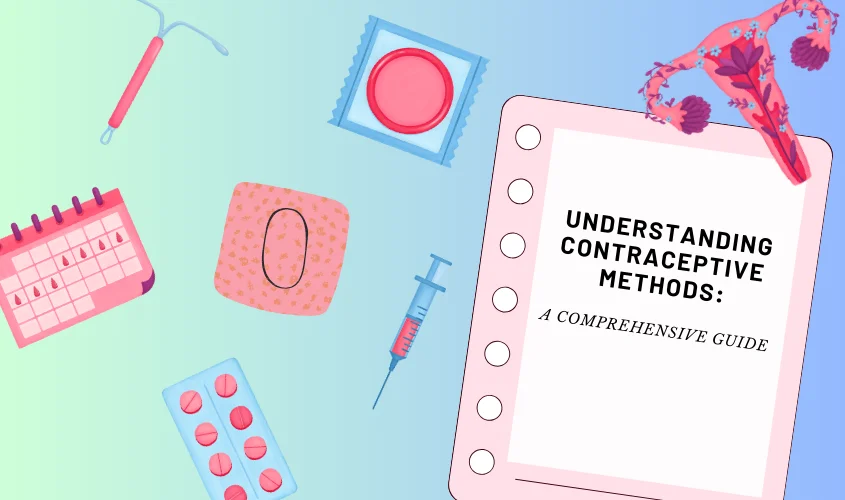
- 10.10.2024
- Birth Control & Options
Introduction to Contraceptive Methods
Choosing the right contraceptive method is crucial for reproductive health and family planning. With various options available, understanding their differences, benefits, and potential side effects is essential. This article will explore the different types of contraceptives, helping you make an informed decision about what’s best for you.
1. Long-Acting Reversible Contraception (LARC)
Intrauterine Devices (IUDs)
IUDs are small, T-shaped devices placed in the uterus by a healthcare professional. They come in two types:
- Hormonal IUDs: These release progestin, which thickens cervical mucus and prevents sperm from fertilizing an egg. They can last between 3 to 7 years, depending on the brand.
- Copper IUDs: These non-hormonal devices create an environment toxic to sperm. They can last up to 10 years and can be used as emergency contraception if inserted within five days after unprotected intercourse.
Overall, IUDs are highly effective, with a failure rate of less than 1%, making them one of the most reliable forms of birth control.
Implants
Implants are small rods inserted under the skin of the upper arm. They release hormones to prevent ovulation and can last up to 5 years. The implant is over 99% effective at preventing pregnancy, making it a convenient option for those seeking long-term contraception.
2. Barrier Methods
Male Condoms
Condoms are a popular choice for preventing pregnancy and protecting against sexually transmitted infections (STIs). They are worn on the penis and are made of latex or polyurethane. With correct usage, male condoms have a typical failure rate of about 13%.
Female Condoms
These are inserted into the vagina and also help prevent STIs. Made of nitrile, female condoms provide a non-hormonal option for women. They offer a similar effectiveness rate as male condoms when used properly.
Diaphragms and Cervical Caps
These barrier methods are inserted into the vagina before intercourse. They must be used with spermicide and can be removed after several hours. The diaphragm is about 88% effective with typical use.
Contraceptive Sponge
The sponge is a soft, disk-shaped device containing spermicide. It is inserted into the vagina before intercourse and provides protection for up to 24 hours. The effectiveness ranges from 76% to 91%, depending on whether a woman has given birth before.
3. Hormonal Methods
Birth Control Pills
Taken daily, these pills release hormones that prevent ovulation. There are various types, including combination pills (which contain estrogen and progestin) and progestin-only pills. The typical failure rate for birth control pills is about 7% when not taken consistently.
Patches
These are applied to the skin and release hormones into the bloodstream. Patches are typically changed weekly and can be effective for up to a month. They work similarly to the pill but offer a more convenient application method.
Vaginal Rings
Flexible rings are inserted into the vagina, releasing hormones for birth control. They are usually replaced monthly, providing an effective and hassle-free option.
4. Fertility Awareness-Based Methods
These methods involve tracking the menstrual cycle to identify fertile days. By avoiding unprotected intercourse on these days, couples can prevent pregnancy. However, it requires diligence and understanding of one’s cycle, making it less reliable than other methods.
5. Emergency Contraception
Used after unprotected sex, emergency contraception can include pills (like Plan B) or the insertion of a copper IUD within a few days of intercourse. This option is intended for occasional use and is not meant to replace regular contraceptive methods.
6. Permanent Methods
Tubal Ligation
A surgical procedure that cuts or blocks the fallopian tubes, making it impossible for eggs to reach the uterus. This method is considered permanent and is suitable for those who are certain they do not want children in the future.
Vasectomy
This procedure for men involves cutting the vas deferens, preventing sperm from entering the ejaculate. It is also intended to be a permanent solution and is highly effective.
Conclusion
Understanding the various contraceptive methods available is essential for making informed choices about reproductive health. Each option has its benefits, drawbacks, and specific considerations. It’s advisable to consult a healthcare professional to discuss which method might be the best fit for your lifestyle and health needs.
Learn More
For more information about contraceptive side effects, check out our article on What Are Contraceptive Side Effects?
Download the Selin App
Stay informed about your reproductive health and track your menstrual cycle with the Selin app.














